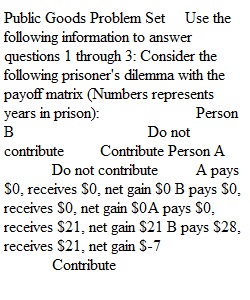


Q Public Goods Problem Set Use the following information to answer questions 1 through 3: Consider the following prisoner's dilemma with the payoff matrix (Numbers represents years in prison): Person B Do not contribute Contribute Person A Do not contribute A pays $0, receives $0, net gain $0 B pays $0, receives $0, net gain $0 A pays $0, receives $21, net gain $21 B pays $28, receives $21, net gain $-7 Contribute A pays $28, receives $21, net gain $-7 B pays $0, receives $21, net gain $21 A pays $28, receives $42, net gain $14 B pays $28, receives $42, net gain $14 1. What is the dominant strategy for player A? a. Contribute. b. Do not contribute. c. There is no dominant strategy. 2. What is the dominant strategy for player B? a. Contribute. b. Do not contribute. c. There is no dominant strategy. 3. What is the Nash Equilibrium? a. $0, $0 b. $-7, $21 c. $14, $14 d. $21, $-7 e. There is no Nash Equilibrium. Use the following information to answer questions 4 through 9: Suppose that there is a positive externality in the market for pizza rolls. The graph below shows the supply and demand curves for pizza rolls. 4. What is the market equilibrium? 5. What is the market price?? 6. What is the optimal quantity? 7. What should the government do in order to ensure the market produces optimal (efficient) quantity? a. Impose corrective taxes (Pigovian taxes) b. Do nothing. c. Impose corrective subsidies (Pigovian subsidies). 8. How big should the government's corrective taxes or subsidies be in this case? 9. As a result of the positive externality, this market a. over produces. b. produces the optimal (efficient) amount. c. under produces. Use the following information to answer questions 10 through 15: Suppose that there is a negative externality in the market for pizza rolls. The graph below shows the supply and demand curves for pizza rolls. 10. What is the market equilibrium? 11. What is the market price? 12. What is the optimal (efficient) quantity? 13. What should the government do in order to ensure the market produces optimal (efficient) quantity? a. Impose corrective taxes (Pigovian taxes) b. Do nothing. c. Impose corrective subsidies (Pigovian subsidies). 14. How big should the government's corrective taxes or subsidies be in this case? 15. As a result of this negative externality, the market a. over produces. b. produces optimal (efficient) amount. c. under produces.
View Related Questions